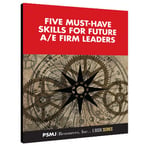 Most managing partners of architecture and engineering firms developed their technical and leadership skills in the trenches of project design. Whether inherited or earned, those who gain the position of managing partner must play a crucial role in a firm’s continued success and growth.
Most managing partners of architecture and engineering firms developed their technical and leadership skills in the trenches of project design. Whether inherited or earned, those who gain the position of managing partner must play a crucial role in a firm’s continued success and growth.
And so—to progress from designer, to manager, to leader—emerging leaders invariably must learn to stretch themselves and take on the challenge of learning new roles and developing new skills.
To be successful in the transition to firm management and firm leadership, you must recognize at a minimum, four key points:
1. The informal atmosphere that the small firm can maintain is no longer possible for a growing firm. Or, if you are moving up through a larger firm, you must appreciate that the relationship you have enjoyed with your coworkers has radically changed. By necessity your professional relationship with them will become more formal and business-like.
2. Your management and leadership style influences the firm’s ability to attract and retain top talent. While there are examples of successful firms with autocratic (dictatorial) leadership, the trend is clearly toward a more participative management style among the most successful firms. Young professionals will only stay under the strong hand of a centralized, autocratic management style as long as it is convenient to them. As soon as they reach a certain professional and financial level, the most capable professionals will move to a more acceptable leadership environment.
3. You must become a team builder. The skills needed to build an effective team are substantially different from those required to become proficient professional designers. Some leaders have
natural talent, but most have to work hard at it.
4. The key to achieving success in any business is directly related to bringing in new work—new clients. Whether or not you enjoy the marketing and sales aspects of business, you must develop your ability to manage clients, establishing and maintaining relationships with them built on trust and mutual respect. The one who “owns” the client has the clout, every time.
 To learn more about the path to firm leadership, check out PSMJ's complimentary ebook Five Must-Have Skills for Future A/E Firm Leaders. Whether you are trying to become a leader in your firm or are an employer looking to develop leaders for your firm's future success, you will find simple, yet effective leadership development strategies in this e-book.
To learn more about the path to firm leadership, check out PSMJ's complimentary ebook Five Must-Have Skills for Future A/E Firm Leaders. Whether you are trying to become a leader in your firm or are an employer looking to develop leaders for your firm's future success, you will find simple, yet effective leadership development strategies in this e-book.



